Sandy landscapes are home to many interesting snakes, from leaf-nosed species to the sand swimmers.
When many hobbyists think of arid land snakes, visions of Trans-Pecos rat snakes (Bogertophis subocularis) and Sonoran gopher snakes (Pituophis catenifer affinis) are often the species that come to mind. There are other arid land species, however, that while less well known, are no less interesting. Some such snakes are from the New World and some are from the Old. Some are venomous, but many are not, and some are large and others small. Some are brightly colored and others are clad in scales that exhibit the hues of the sands they inhabit.
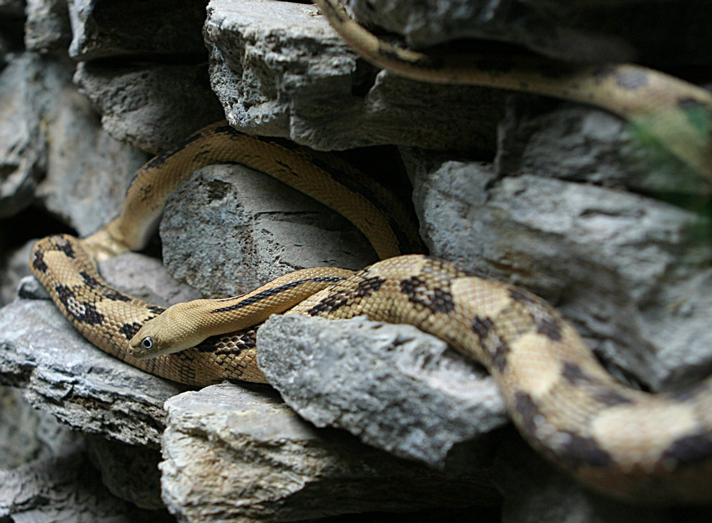
cburnett/wikipedia
Trans-Pecos rat snake (Bogertophis subocularis).
Some of these sand and scrub-dwelling snakes are readily available from traditional sources, at least seasonally, but others are very seldom seen. The life histories of some are rather well understood, and about others we know very little. Let’s take a look at a few of these serpentine obscurities, their availability, and their needs.
Leaf-Nosed Snakes
The species in the genus Lytorhynchus are known in the U.S. as the Arabian leaf-nosed snakes, and elsewhere as the awl-headed snakes. The species most commonly available is L. diadema gaddi, a pretty little tan snake with a row of well-defined, dark brown, midorsal blotches and an equally well-defined dark interorbital bar, as well as some small and vague lateral spots.
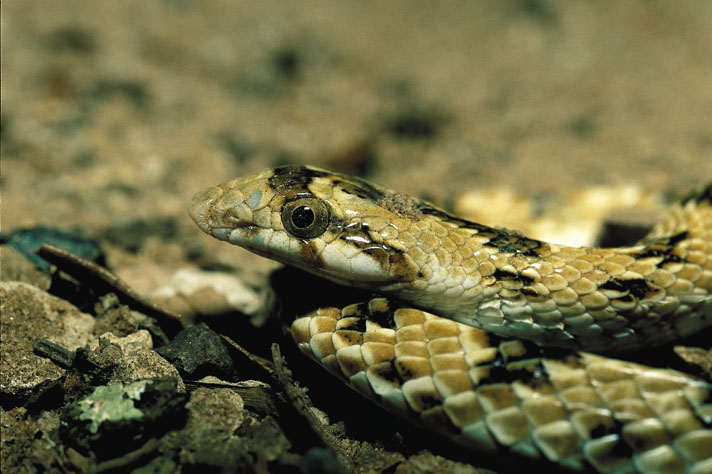
dick bartlett
The enlarged nose scale of the leaf-nosed snakes (this is Lytorhynchus diadema gaddi) is thought to aid them in digging lizard prey out of the sand.
The common name of “leaf-nosed snake” is derived from the edges of the large rostral shield. It is thought that this specialized nose-tip scale assists Lytorhynchus in digging lizards—said to be their principal prey—from beneath the sand.
Arabian leaf-nosed snakes are adult at a length of about 15 inches and those available to date have been wild-collected. Although specimens have been known to live for more than six years in captivity, in the U.S., Lytorhynchus have generally not done well, feeding sparingly and usually surviving only a few months. Among other causes, their short longevity may be due to shipping stress that has allowed endoparasites to proliferate, cage humidity that is too high, or they may be offered incorrect prey. In other words, we’re still guessing!
In the southwestern United States and northwestern Mexico there are two species of leaf-nosed snakes of the genus Phyllorhynchus. These are the saddled (P. browni) and the spotted (P. decurtatus). Both have subspecies.
Leaf-noses are found on shrub-studded sandy and gravelly desert habitats. They are often seen on desert roadways during both spring and the monsoon season.
The two species, which are quite dissimilar in appearance, have proven difficult captives; in fact, they are even more difficult to keep than their previously mentioned Arabian lookalikes. The reason is simple: Phyllorhynchus often do not eat well in captivity. The suggested prey for both American leaf-noses is geckos and their eggs. However, few hobbyists have succeeded in keeping these snakes over a long period.
Both species are adult at about 16 inches. The saddled leaf-nosed snake has a ground color of beautiful tannish gray and exhibits large, precisely delineated, chocolate saddles. The spotted leaf-nosed snake is sandy in color, with a busy pattern of reddish-brown spots.
Mexican Short-tailed Snake
Because were discussing snakes about which we know little, next up is a little Mexican desert species called the Mexican short-tailed snake (Sympholis lippiens). This robust, 18-inch-long, harmless snake is found in western Mexico from southern Sonora to Jalisco.
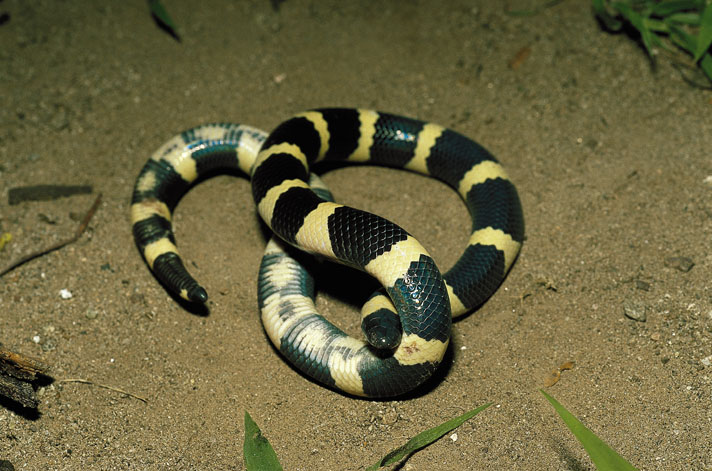
dick bartlett
The Mexican short-tailed snake (Sympholis lippiens) is an attractive species found in western Mexico.
As of this writing, virtually nothing is known about the biology of Sympholis. It can be found on roadways, sometimes in fair numbers, during the monsoon season, but never has one been found with any contents in its stomach.
Sympholis lippiens is clad in rings of jet black and creamy yellow. It has very small eyes, a loose-feeling skin, and as indicated by its common name, a short, stubby tail. Speculation is that it consumes termites, ant pupae and/or grubs, but the life history of this snake is a modern-day enigma, an omission that is made all the more lamentable by the fact that it is not an uncommon species.
Sidewinder Rattlesnakes
The sidewinder (Crotalus cerastes, with three subspecies) is a small desert rattlesnake found over pretty much the same range as the American leaf-nosed snakes. An abundant species, the sidewinder prefers areas of yielding “blow-sand” into which it can quickly sidle from sight. In the wild, this 2½-foot-long rattler eats lizards and small mammals, and it is another desert snake that can be seen regularly on warm spring and summer nights as it moves across desert roads.
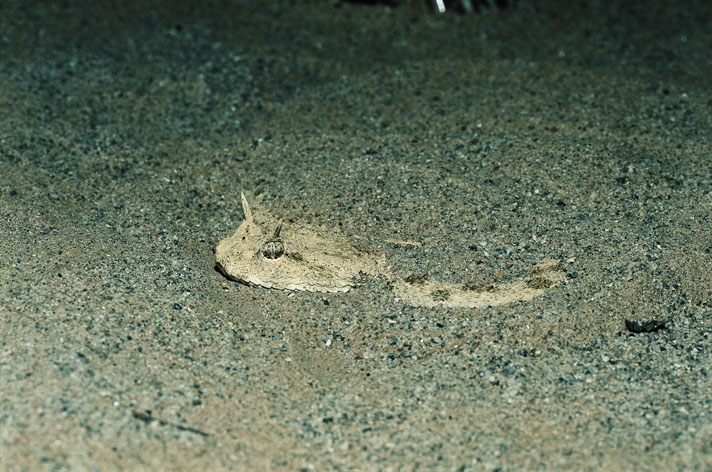
dick bartlett
Sidewinders such as this Mojave sidewinder (C. c. cerastes) will bury themselves in the sand while they wait to ambush prey.
The three races of sidewinder are very similar in appearance. The Mojave sidewinder (C. c. cerastes) has 21 scale rows and a brown basal rattle segment. The Sonoran sidewinder (C. c. cercobombus) has scales in 21 rows and the basal rattle segment is black, and the Colorado desert sidewinder (C. c. laterorepens) has a black basal rattle segment and scales in 23 rows.
If they are kept dry and warm with day temps between 90 and 93 degrees Fahrenheit (nights can be cooler), sidewinders make reasonably hardy little captives. However, they can be irascible, too, and are not for beginners. The keeping of sidewinders and other venomous species may be locally or state regulated. Be sure to keep abreast of the ever-changing laws and/or regulations.
The common name of “sidewinder” is derived from the snakes’ mode of locomotion. When startled, a sidewinder will “throw” loops of its body forward across the sand at a 45-degree angle from the direction its head is pointing.
Sidewinders move quickly and with surprising agility, and they are not the only snakes to move in this manner. Desert-dwelling venomous snakes of many species from across the world, including numerous viper species of Old World distribution, may “loop” themselves forward, as well.
Sidewinders And Other Sand Dwelling Snakes
Not only do they move like the sidewinders, but the Pakistani whiskered viper (Eristocophis mcmahoni) and two Cerastes species from the Middle East, the horned viper (C. cerastes) and the common sand viper (C. vipera), all conceal themselves and forage in the manner of a sidewinder, as well (if, in fact, concealment near a prey trail can be considered foraging). Concealment in the loose sand of their habitat is accomplished within seconds, when a snake flattens itself and shuffles its body from side to side, displacing and sinking beneath the sand. It may bury itself entirely, or the eyes or head may remain above the sand. Once hidden, these wait and ambush predators may remain for long periods in wait of a lizard or small rodent.
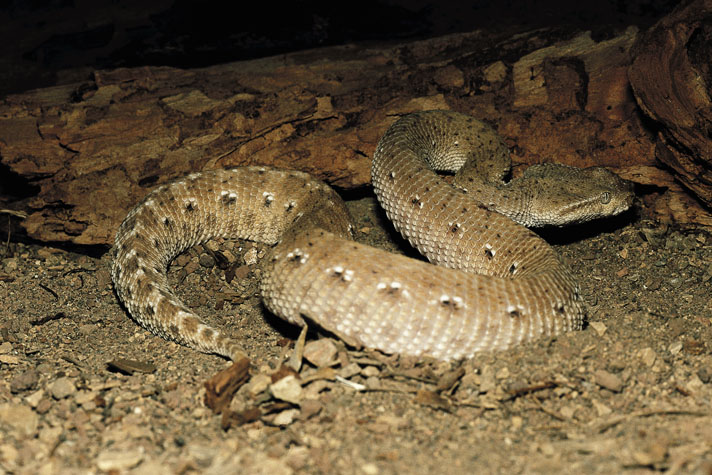
dick bartlett
The Pakistani whiskered viper (Eristocophis mcmahoni) moves in a fashion similar to that of a U.S. sidewinder.
Other sand-shuffling species include the Field’s horned viper (Pseudocerastes fieldi) from the Middle East and southern Africa’s horned adder (Bitis caudalis). Any of these snakes have a complex venom, and any that may be encountered in the reptile trade are best kept only by the most experienced hobbyists.
There are no harmless desert snakes that sidewind their way across loose sand, but there are some that are “sand swimmers.” Two such genera found in the American southwest and northwestern Mexico are the shovel-nosed snakes Chionactis and the sand snakes of the genus Chilomeniscus. The shovel-noses are banded and the sand snakes may be banded or patternless. All have concave venters that help them retain traction while moving beneath loose sand. These can be great snakes for hobbyists who may be queasy about feeding rodents or lizards to their pets, because all members of both genera are insectivorous.
Snakes That Eat Insects
The ground snakes and hook-nosed snakes of the genera Sonora, Gyalopion and Ficimia are also insectivores and inhabitants of rocky desert habitats. These snakes feed on crickets, grubs, wireworms and other such fare.
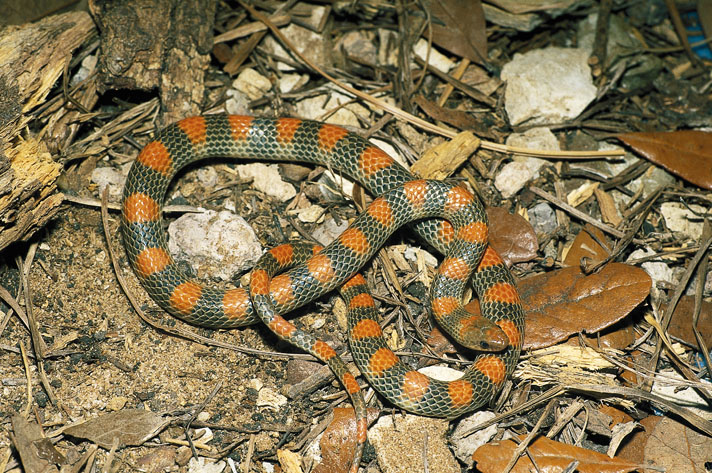
dick bartlett
The Great Plains ground snake (Sonora semiannulata) is an extremely variable species when it comes to appearance.
The ground snakes are represented in the U.S. by only a single species, the Great Plains ground snake (S. semiannulata), which is immensely variable in both color and pattern. In southern Texas, this foot-long snake may be gray with a vaguely darker head, tan with red saddles, olive with gray saddles, or russet with a redder stripe elsewhere.
South of the border, the file-tailed ground snake (S. aemula) is a coral snake mimic and it, too, is variable. The ground color is red and the bands are black and white, but the number of bands can range from one to many.
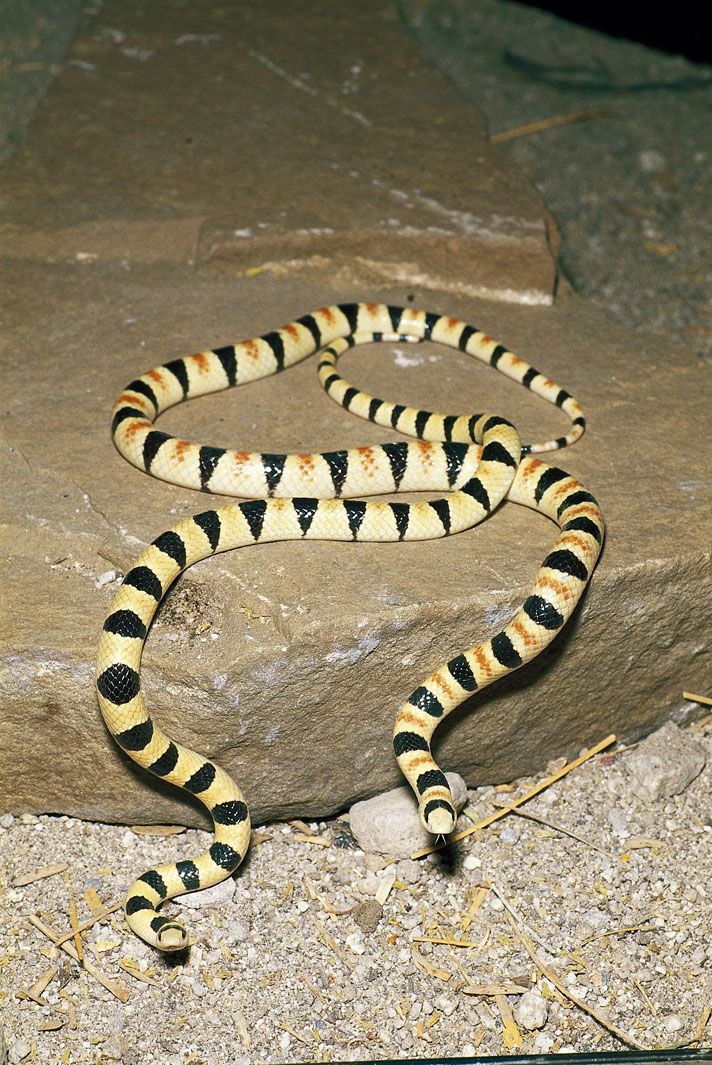
dick bartlett
Chionactus annulatus is a shovel-nosed species found in the southwestern U.S. and northwestern Mexico.
There are three hog-nosed snake lookalikes, two in the genus Gyalopion and one in Ficimia. Two display earthen hues and one is brightly colored. All three occur in the United States but with primarily Mexican distribution.
The western hook-nose (G. canum) and the Mexican hook-nose (F. streckeri) are the more dull-colored species and range northward as far as central New Mexico and southern Texas. In the U.S., the more attractively colored thornscrub hook-nose snake (G. quadrangulare) occurs only in southeastern Arizona.
Diminutive though it may be, I think the thornscrub hook-nose is one of the loveliest snakes of the Americas. It has strawberry sides, black and white vertebral blotches, some dark banding on the sides, and the impertinent, snub-nosed look of those perennial favorites, the hog-nosed snakes.
Hook-noses are fully grown at about a foot in length. Often considered specialist feeders on spiders, both hook-noses actually eat grubs and other burrowing insects, as well. Captive snakes will eat waxworms ravenously.
Although some snake species eat a wide variety of prey, others are prey specialists. Two of these are the mildly venomous centipede-eating snake (Aparallactus sp.) from Africa and some of the New World crowned snakes of the genus Tantilla. The snakes comprising these two genera are similar in appearance, with tan bodies and black heads. Although centipedes figure prominently in the diets of many of these snakes, they will also eat other forms of scuttling and burrowing arthropods. Neither genus is well represented in the pet trade, and both the crowned snakes and the centipede-eaters vary in size from about 6 to 24 inches in length.
Enclosures for Sand Dwelling Snakes
Naturalistic terraria work well for sand-dwelling snakes, and of the many terrarium types, desert or aridland setups are among the easiest to build, outfit and maintain.
Aridland setups can be created in virtually any size enclosure. Of course, the size of the terrarium that you decide to construct and the furniture (including substrate and live plants) that you choose to include in it will directly correlate to the size, number and activity patterns of the snake inhabitants. For example, six hook-nosed snakes may be maintained in a 15 or 20-gallon “long” style terrarium appointed with a gravelly sand substrate, Opuntia cactus skeletons for hiding, and delicate plants, but larger, more active species would require at least a 50-gallon (preferably larger) terrarium with spacious hiding spots and very sturdy plants.
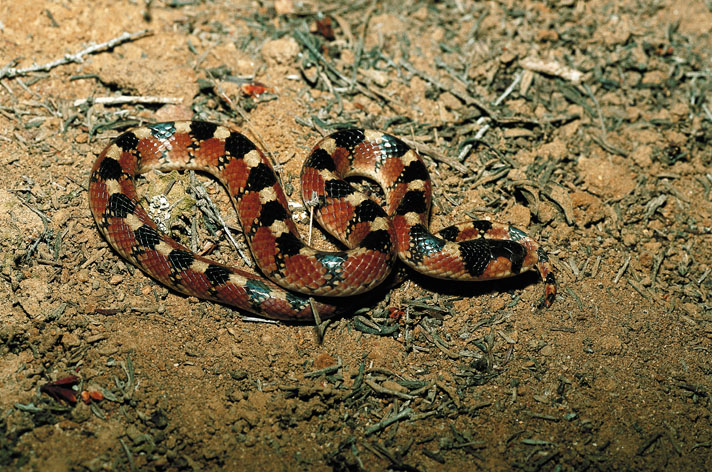
dick bartlett
The author considers the thornscrub hook-nosed snake (Gyalopion quadrangulare), found in southeastern Arizona, one of the most beautiful snakes in the Americas.
The composition of the substrate can vary, but aridland habitats are usually sandy (or gravelly) and dry, with sparse to thick cover provided by drought-tolerant plants. Because sand, weathered wood (driftwood), attractive rocks and many plants are usually readily available in home improvement stores, the materials needed for desert setups are easily obtained.
Keep in mind as you are building your desert setup that sand is heavy. Be sure that the terrarium stand is equal to its proscribed tasks of not only supporting the considerable weight of your finished masterpiece, but fully supporting the tank on all four sides lest the glass crack from uneven weight distribution.
One of the best things about a desert terrarium is that it doesn’t have to be fancy to look great and be serviceable. Whereas other terraria, such as a tropical setup, may need layers of graded strata to provide suitable drainage, this is not necessary with a desert enclosure. You need only to decide on the kind of desert snakes you intend to keep, then find the sand that you want to use.
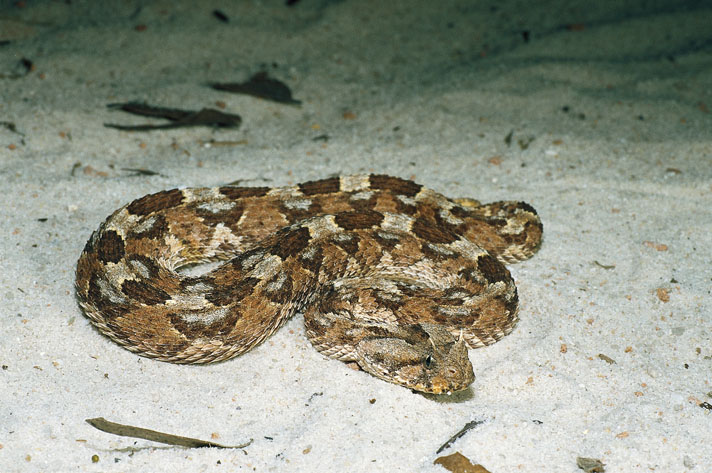
dick bartlett
The horned adder (Bitis caudalis) is another sand-shuffling, wait-and-ambush predator.
Smooth desert sand seems better than sharp silica playsand, but either works. Many hobbyists prefer the smooth desert sand because it is usually of a more attractive (often reddish) color and seems more easily passed if accidentally ingested than sharp silica. If the snake species you have decided on is more at home on a gravel than on a plain sand substrate, mix some gravel with the sand before adding it to the tank to the desired depth.
Even burrowing snakes often are found beneath rocks, cactus skeletons, or in the shade, near the root system of a shrub. Similar options should be provided for captive snakes.
Though deserts are known for their dryness and heat, they are not 100-percent dry, and most deserts cool noticeably at night and in the winter. Thus, by burrowing or otherwise secluding themselves, reptiles are often able to avoid absolute dryness and debilitating heat. For example, although the sand surface in the Mojave Desert may reach 150 degrees Fahrenheit on a hot summer day, the sand surface, even in the sparse shade cast by a scraggly creosote bush, may be only 100 degrees. And while the relative humidity at the sand’s surface may be only 15 to 30 percent, it is often possible to attain a humidity level of 50 to 70 percent by burrowing a few inches into the sand.
As in a desert, the top layers of sand in a terrarium should be kept dry. However, keep the very lowest layers of a sandy substrate somewhat moist. This may be easily accomplished by trickling water slowly into a vertical standpipe (a piece of small-diameter PVC or the plastic tube from a turkey baster works well for this) and allowing it to percolate outward along the glass bottom of the terrarium. A little water will go a very long way in a desert setup, so be sure not to overdo it.
Provide a thermal gradient. The hot end of the tank should be about 92 to 95 degrees, and the cool end can be room temperature (72 to 82 degrees). A basking light will be appreciated by some snakes and may be utilized even when the snakes are subsurface.
Plant choices, if desired, will be based on a few things: what kind, how active and how large the snakes in the terrarium will be, and whether or not you want to keep your setup true to a continent. In other words, if your snakes are of Asian or African origin you may not want to use cacti as they are of American origin. And with larger snakes, for instance, you won’t want to use a jade plant from which branches will be broken with only a slight bump, but if you have small snakes and want a pretty tank, incorporate whatever succulent plants, including jade, that you find attractive.
Bear in mind that some of the longer-spined cacti (especially those with recurved spines) can be difficult for you to handle and might impale a thrashing snake. Otherwise, some hardy, safe and attractive plant choices are Haworthia, Sanseveria and some small, short-spined cacti.
Plants can be easily placed in the terrarium by burying their pots up to the rim in the substrate. To grow properly, desert plants need a considerable amount of light. Insufficient light promotes weak and lanky growth and eventual death. If sufficient light cannot be provided to your plants without overheating your terrarium, you may wish to keep two sets of plants: one for the terrarium and the other growing on a sunny windowsill. Switch the plants out each week.
Weathered wood can be used to camouflage hide boxes, or pieces that are flat and lightweight may be laid atop the sand for the snake to hide beneath. Be sure such décor is supported so it cannot settle onto a burrowing snake. Opuntia (cholla cactus) skeletons make ideal hiding spots for small snakes. Rocks also make excellent hide box camouflaging and visual barriers. Again, be certain that rocks cannot settle on and injure burrowing snakes.
When present, a water bowl will increase the humidity in a desert terrarium. This is especially so if the water bowl is above a heat source, such as heat tape. Therefore, always place the water bowl at the cool end of the terrarium. If you live in a particularly humid area, such as the southeastern United States, it may be prudent to provide water for your snakes only twice a week, removing the water bowl after 24 hours.
Although the snakes described in this article may not be as widely known as some favorite pet species, snake enthusiasts should acquaint themselves with them. Whichever you may eventually keep, you will witness some interesting behaviors as the animals adapt to life in their sandy domain.
Dick Bartlett is a herpetologist/herpetoculturist who has written hundreds of articles and many books, some with his wife, Patti. He has bred 175 captive herp species. A frequent lecturer, he has participated in field studies in North and Latin America, and he has led tours to the Peruvian Amazon.



